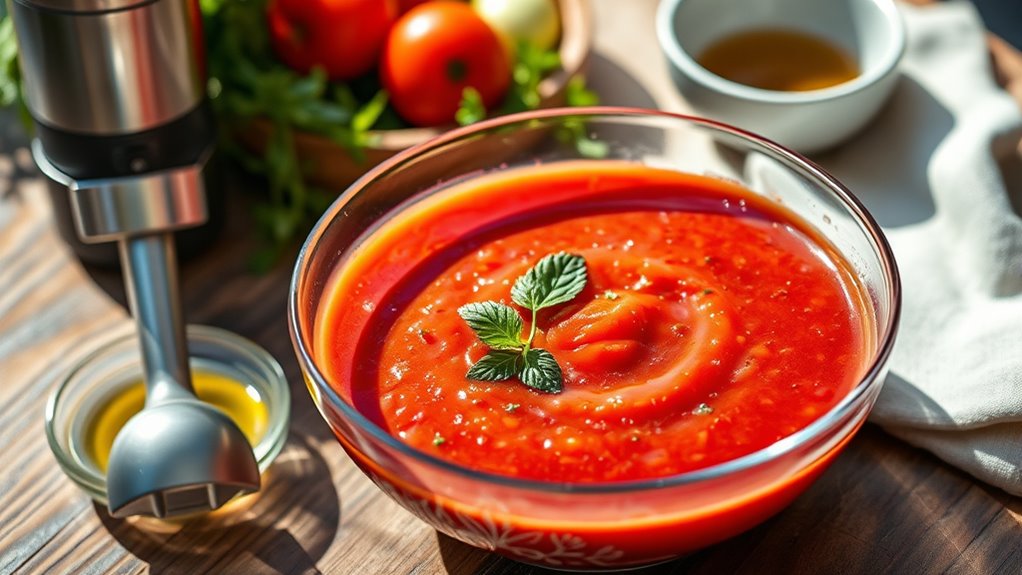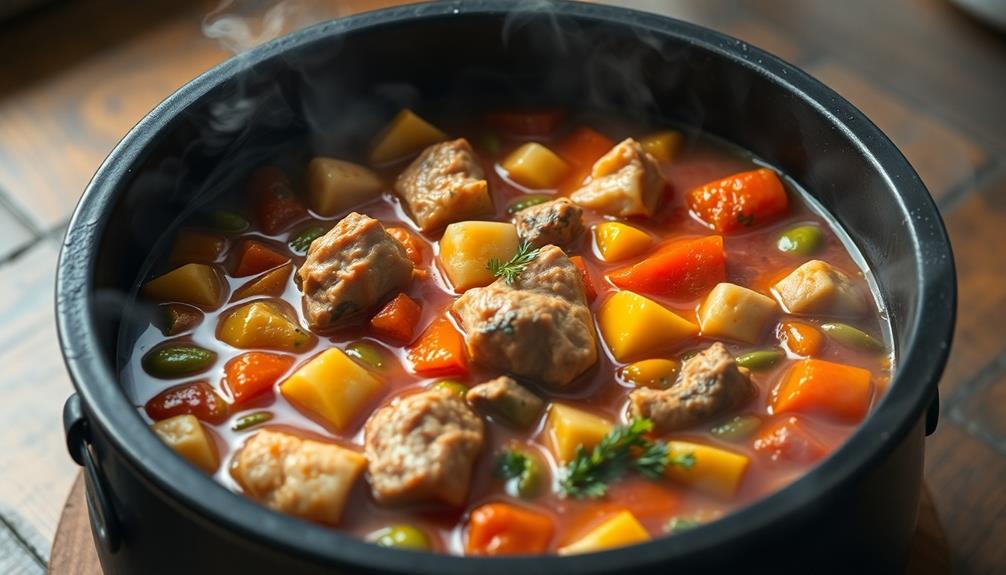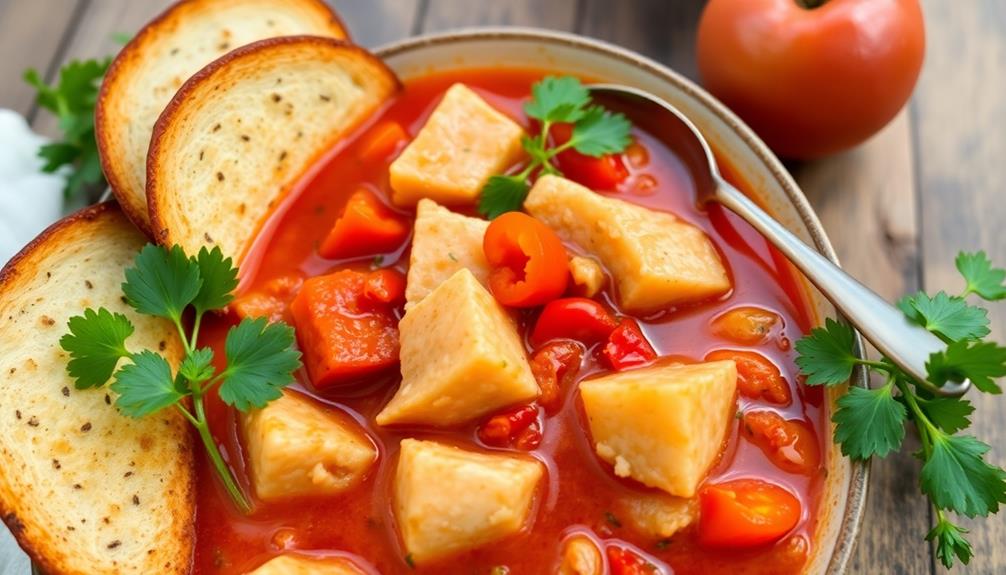To craft a silky Spanish gazpacho, start by blending your ingredients on low to medium speed to prevent froth and air bubbles. Drizzle olive oil slowly in a thin stream while blending to create a stable emulsion, giving the soup its velvety texture. Gradually add vinegar, tasting as you go to balance acidity. For an ultra-smooth finish, pass the mixture through a fine sieve. Keep experimenting with these tips to perfect your gazpacho’s signature consistency.
Key Takeaways
- Drizzle olive oil slowly in a thin stream during blending to create a stable, silky emulsion.
- Begin blending at low or medium speed to break down ingredients without incorporating excess air.
- Gradually increase blender speed for a smooth, velvety texture, avoiding over-blending that can cause froth.
- Pass the gazpacho through a fine sieve for an ultra-smooth, refined finish.
- Chill thoroughly before serving to help set the emulsion and enhance the soup’s silky mouthfeel.

Spanish gazpacho relies heavily on proper emulsification to achieve its signature smooth and velvety texture. To get there, you need to pay close attention to how you blend your ingredients, especially when it comes to vinegar balancing and blender techniques. Vinegar plays an essential role in enhancing flavor, but too much can make the soup overly acidic, while too little can leave it bland. You want to add vinegar gradually, tasting as you go, to find that perfect balance that complements the freshness of the tomatoes and cucumbers without overpowering them. A good rule of thumb is to start with a teaspoon and increase gradually, guaranteeing the acidity enhances rather than dominates.
Achieve perfect gazpacho with gradual vinegar addition and careful blending for velvety, balanced flavor.
When it comes to blender techniques, the way you process your ingredients directly impacts the emulsion. For a silky, velvety texture, avoid over-blending at high speeds initially. Instead, start on a low or medium setting to break down the vegetables evenly. Once the ingredients are roughly pureed, increase the speed gradually. This ensures a smooth, homogeneous mixture without introducing unnecessary air bubbles that can destabilize the emulsion. Using a high-powered blender can help achieve a finer, creamier consistency, but be careful not to over-process, which can cause the gazpacho to become frothy or thin. Incorporating a proper blending technique is crucial for the perfect emulsion. Additionally, understanding the role of emulsifiers like olive oil can further improve the stability of your soup.
Another tip for proper emulsification is to incorporate a small amount of olive oil during blending. As you process the mixture, slowly drizzle in the oil in a thin, steady stream. This technique helps create a stable emulsion, giving the soup its characteristic velvety texture. If you add the oil too quickly or all at once, it can separate, ruining the smoothness you’re aiming for. Keep in mind that the right balance of oil, vinegar, and vegetables is essential for a cohesive, flavorful soup. Paying attention to ingredient quality and using fresh, ripe produce will also significantly impact the final result.
Additionally, understanding the role of organization and assessment in maintaining a well-balanced flavor profile can help in adjusting ingredients over time for consistent results. Finally, after blending, you can further refine your gazpacho by passing it through a fine sieve or chinois. This step removes any remaining pulp or fibrous bits, resulting in an ultra-smooth finish. Chill the soup thoroughly before serving, as cold temperatures help the emulsion set and enhance the overall texture. With these blender techniques and vinegar balancing tips, you’ll craft a gazpacho that’s not only invigorating but also perfectly silky and well-emulsified, making every spoonful a delight.
Frequently Asked Questions
Can I Use a Blender Instead of a Traditional Mortar and Pestle?
You can definitely use a blender instead of a traditional mortar and pestle. While a mortar helps you control emulsification techniques more precisely and adds a rustic touch, a blender offers quick and efficient pureeing. To achieve a silky texture, blend the ingredients gradually and pulse to avoid over- emulsifying. Both tools work, but your choice depends on the texture you want and how much control you prefer during emulsification.
How Do I Prevent My Gazpacho From Separating After Blending?
Think of your gazpacho as a delicate dance that needs perfect harmony. To prevent oil separation, avoid over-blending, which can break the emulsion. Keep your blending duration just long enough to achieve a smooth, silky texture—about 30 seconds to a minute. Using a gentle hand helps maintain the mixture’s stability, ensuring your gazpacho stays unified and luscious, rather than splitting apart like a poorly choreographed routine.
What Are Some Alternative Oils to Enhance the Emulsion?
You can try different olive oil variations or flavor-enhancing oils to improve your gazpacho’s emulsion. For a richer taste, use extra virgin olive oil, but if you want a milder flavor, consider light olive oils. You might also experiment with oils like avocado, walnut, or sesame oil for unique flavors that help preserve a silky texture. Just add them gradually while blending to ensure a smooth, well-emulsified gazpacho.
Is It Necessary to Strain the Gazpacho for a Smoother Texture?
Think of straining your gazpacho like polishing a gemstone—it’s about revealing its true shine. Straining benefits include removing pulp and seeds, resulting in a smoother, more refined texture. If you want a velvety consistency that feels like silk on your palate, straining is essential. However, if you’d prefer a slightly rustic, textured soup, you can skip this step. Consider your texture preferences to decide what’s best for your gazpacho.
How Long Should I Blend to Achieve Perfect Emulsification?
To achieve perfect emulsification, you should blend the gazpacho for about 30 to 60 seconds. Keep an eye on the texture and stop blending once it’s smooth and silky. Avoid over-blending, which can make it too thin or frothy. The key is to blend just enough to combine all ingredients thoroughly, ensuring a velvety consistency without breaking the emulsion. Your gazpacho will have a perfect, silky texture.
Conclusion
Now that you’ve revealed the secrets of emulsification, your gazpacho will sing with silky smoothness like a well-tuned orchestra. Think of each blend as painting a vibrant, flavorful landscape on your palate, where every swirl and whisk brings harmony and depth. With these tips, you’re not just making soup—you’re crafting a revitalizing masterpiece that dances like sunlight on water. So, embrace the technique, and let your gazpacho become a symphony of cool, luscious perfection.










